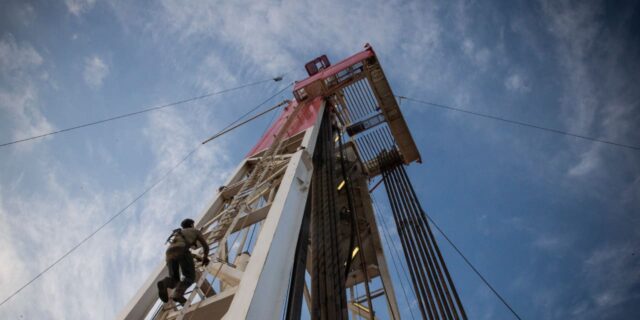The weather in North Dakota has managed to do what Houthi rebels operating in the Red Sea have so far failed to — disrupt the supply of oil.
Low temperatures across the state of North Dakota last week led to disruptions to oil production in the Bakken, which contains one of the largest deposits of oil and natural gas in the United States.
Read: Here’s what’s been keeping a lid on oil prices despite risks of a wider war in the Middle East
As much as 700,000 barrels a day of oil production may have been lost over the past week, Lynn Helms, director of North Dakota’s Department of Mineral Resources, said on Saturday, according to local television station KFYR-TV.
State authorities have said that it could be another several weeks or even months until production operations are fully restored due to potential damage that has not yet been fully assessed, Tyler Richey, co-editor at Sevens Report Research, told MarketWatch.
The fact that over 90% of North Dakota’s oil and gas is derived from fracking and horizontal drilling practices “only adds to the complications for bringing operations back online,” Richey said. Some wells have associated natural gas that’s related to the production of crude oil.
“Like birds of a feather flying together, oil and natural gas flow out of wells together such that stoppage of natural-gas pipelines means that oil production must also be stopped,” said Manish Raj, managing director at Velandera Energy Partners. “It is a tragedy that oil production must be curtailed, even though only the natural-gas infrastructure is affected by cold temperatures.”
Raj told MarketWatch that the shut-ins are “temporary, as wells can be reopened usually within a week.”
And when wells are reopened, “they come roaring back to make up for the shortfall,” he said. “Therefore, we don’t expect much production loss from this episode.”
The local news station, however, reported that Helms said “it will be a long, slow recovery,” and that “a lot of times these things take a month from the time that it hits until we see back to normal production.”
The news station also reported that subzero temperatures resulted in more than 60 incidents involving leaks or equipment failure. Helms said that as temperatures start to rise, that number is expected to climb.
Preliminary data from the state pipeline authority’s website show that for November 2023, oil production was at 1.28 million barrels a day.
North Dakota is the third top oil-producing state in the U.S., according to the State Historical Society of North Dakota, producing 10% of all U.S. oil.
That’s a notable chunk of overall U.S. oil production, which rose by 100,000 barrels per day to 13.3 million barrels per day for the week that ended Jan. 12, according to the Energy Information Administration. That total matched the record seen for the week that ended Dec. 22.
Record oil production in the U.S. has helped to offset concerns about disruptions to shipping in the Red Sea, where attacks on vessels by the Iranian-backed Houthi militant group have forced many shipping companies to reroute vessels around Africa’s Cape of Good Hope.
Analysts have said that the biggest impact of the Red Sea issues are the shipping costs and longer shipping times.
Read: Why Red Sea chaos is driving oil buyers ‘into the arms of U.S. shale producers’
“Red Sea disruptions cause annoyance rather than production losses,” Velandera Energy’s Raj said. “Sure, shipping rates go up and some routes get backlogged, but oil eventually reaches the destination and therefore dislocations are only temporary.”
Given that, the oil-market response has been “muted, barring permanent changes in supply or demand equation,” he said.
On Tuesday, U.S. benchmark West Texas Intermediate oil for March delivery
CL.1
settled at $74.37 a barrel on the New York Mercantile Exchange, down 39 cents, or 0.5%.



